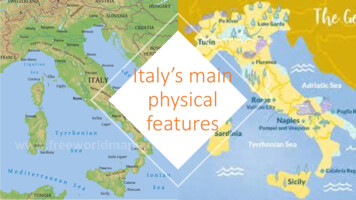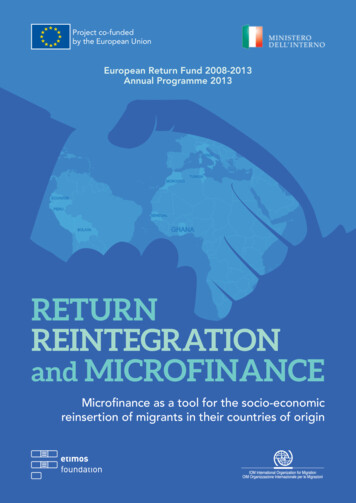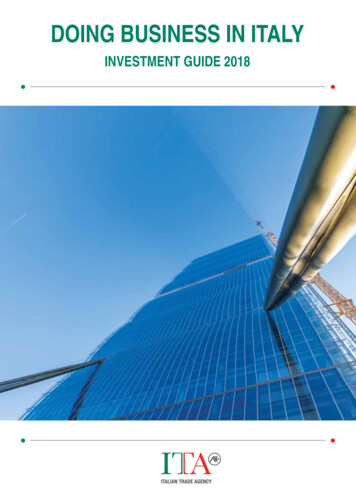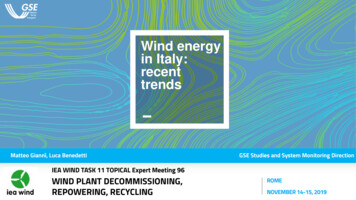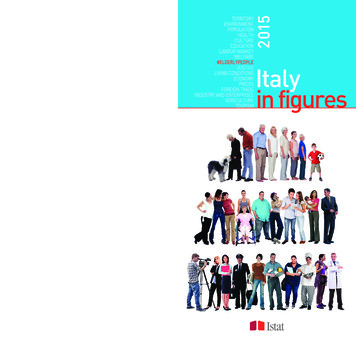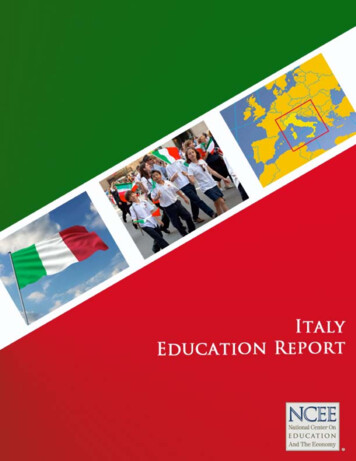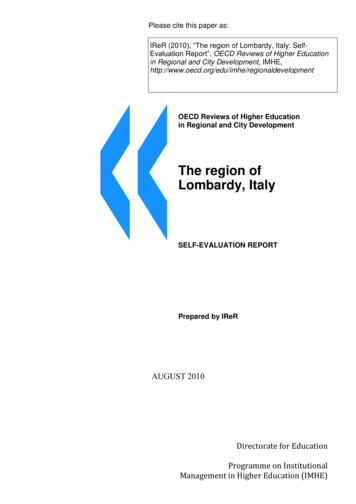
Transcription
Please cite this paper as:IReR (2010), “The region of Lombardy, Italy: SelfEvaluation Report”, OECD Reviews of Higher Educationin Regional and City Development, entOECD Reviews of Higher Educationin Regional and City DevelopmentThe region ofLombardy, ItalySELF-EVALUATION REPORTPrepared by IReRAUGUST 2010Directorate for EducationProgramme on InstitutionalManagement in Higher Education (IMHE)
This report was prepared by IReR – Lombardy Regional Institute for Research with the supportof the Lombardy Regional Steering Committee as an input to the OECD Review of HigherEducation in Regional and City Development. It was prepared in response to guidelinesprovided by the OECD to all participating regions. The guidelines encouraged constructive andcritical evaluation of the policies, practices and strategies in HEIs‟ regional engagement. Theopinions expressed are not necessarily those of the Lombardy Region, the Lombardy RegionalSteering Committee, the OECD or its Member countries.2
Table of contentsLIST OF TABLES, FIGURES AND BOXES7LIST OF ACRONYMS9FOREWORD13COMPONENTS OF STEERING COMMITTEE AND WORKING GROUP15CHAPTER 1OVERVIEW OF THE REGION1.1. The geographical situation1.2. The demographic situation1.2.1. Immigration1.2.2. Young immigrants in Lombardy1.2.3. Natural demographic trends1.2.4. Ageing population1.2.5. Intra-regional population disparities1.2.6. Educational attainment1.2.7. Health and wellbeing1.2.8. Cultural life1.3. The economic and social base1.3.1. GDP1.3.2. Industrial structure1.3.3. Research and development (R&D)1.3.4. Distribution of economic activities1.3.5. Exports and Foreign Direct Investments (FDI)1.3.6. Labour market1.4. Lombardy governance structure1.4.1. Local government structure1.4.2. Structure of Regional Government1.4.3. Competences of the Region1.4.4. Revenues1.4.5. Regional budget1.4.6. Competences regarding 737393939CHAPTER 2CHARACTERISTICS OF THE HIGHER EDUCATION SYSTEM2.1. The Italian higher education system2.2. Highlights on Italian higher education2.3. Governance of the national system of higher education2.4. Overview of the Italian system of higher education2.4.1. Universities2.4.2. Students2.4.3. Personnel2.4.4. Financial resources2.4.5. Academies and conservatories (AFAM)2.4.6. Professional training/education institutes2.5. The higher education system in Lombardy2.5.1. Universities2.5.2. Students2.5.3. Personnel2.5.4. Financial resources and evaluation434344444646464951515252525557573
2.5.5. Academies and conservatories (AFAM)2.5.6. Professional training/education institutes: Poli formativi2.5.7. The University of Lugano (Switzerland)585960CHAPTER 3CONTRIBUTION OF RESEARCH TO REGIONAL INNOVATION3.1. The national framework3.2. The regional framework3.3. The Regional Innovation System3.4. Technology Transfer in Universities3.5. Innovation in companies3.6. Conclusion61616263666874CHAPTER 4CONTRIBUTION OF TEACHING & LEARNING TO LABOUR MARKET ANDSKILLS4.1. Localising the learning process4.2. Student recruitment4.2.1. Students mobility4.2.2. Collaboration between universities and Regional Scholastic Office4.3. Regional employment4.3.1 Placement4.3.2. Extra-curricular activities4.3.3. Postgraduate4.3.4. Links between universities and companies in the Region4.4. Lifelong learning, continuing professional development and training4.5. Changing forms of educational provision4.6. Enhancing the regional learning system4.7. Conclusion7777787879808081828283858687CHAPTER 5CONTRIBUTION TO SOCIAL, CULTURAL AND ENVIRONMENTALDEVELOPMENT5.1. Social development5.1.1. Activities undertaken in collaboration with the Regional Health System5.1.2. Educational and professional attainments for school chiefs and teachers5.1.3. Welfare activities in favour of university students5.1.4. The intermediary role of the university in social development (partnership andpromotions)5.1.5. Development of local partnership5.2. Cultural development5.2.1. Centre for the exploitation of Lombardy‟s cultural heritage5.2.2. Catalogue of Lombardy‟s Cultural Heritage5.2.3. Expo 20155.3. Environmental sustainability5.3.1. Lombardy Foundation for the Environment5.3.2. EnergyLab Foundation5.3.3. University courses and MastersCHAPTER 6CAPACITY BUILDING FOR REGIONAL COOPERATION6.1. Mechanisms to promote regional engagement of HEIs6.2. Evaluating and mapping the impact of the regional HE system6.3. Institutional capacity building for regional 0
6.4. Human and financial resources management6.5. Creating a new organisational culture101101CHAPTER 7CONCLUSIONS: MOVING BEYOND SELF-EVALUATION7.1. Institutions of higher education and economic and social development7.2. Actions and role of the Regional Government7.3. Higher education institutions and the knowledge economy7.4. Higher education institutions and demographic change7.5. Higher education institutions and sustainable development7.6. Promotion and development of greater inter-istitutional coordination103103103105106106107LIST OF REFERENCES109DATA BASES113LIST OF LAWS115ANNEXES1. Italian regions: area and population2. Foreign students in Lombardy universities: an overview3. Lombardy industrial districts4. Lombardy meta-districts5. The Lombardy Regional Executive (Giunta regionale)6. Competences of State and Regions7. Indicators adopted for allocation of 7% of FFO - Fondo per il Finanziamento Ordinario8. Distribution of faculties among Lombardy provinces9. Portfolio of innovation measures10. Higher education institutions profilesBocconi universityUniversity Carlo Cattaneo - LIUCIULM - Institute of modern languagesPolitecnico di MilanoUniversità Cattolica del Sacro Cuore (UCSC)University of BergamoUniversity of BresciaUniversity of InsubriaUniversity of MilanUniversity of Milan-BicoccaUniversity of PaviaBrera academy of fine 691771851911972092152215
6
LIST OF TABLES, FIGURES AND BOXESTABLESTable 1.1 Foreign residents: countries of origin, year 200921Table 1.2 % of foreigner in Lombardy among young population aged 18-25 years old,years 2003, 2009, 2020, 2030Table 1.3 Natural demographic trends, years 1992-2009 (thousands)22Table 1.4 Population - Intra-regional disparities, year 200924Table 1.5 Composition of the population by degree of education, year 1999, 2004and 2008 (percentages)25Table 1.6 Satisfaction in Italy and in Lombardy26Table 1.7 Firms per size classes29Table 1.8 Value added by economic sector30Table 1.9 Internet diffusion among firms (percentages)31Table 1.10 Main features of meta-districts, year 200133Table 1.11 Division of competences between State and Regions37Table 1.12 Revenue and State transfers Lombardy Region, years 2005-201038Table 1.13 Agreement between the Lombardy Region and the Ministry of Education,University and Research (19th July 2010) - Subjects and goalsTable 2.1 Professors who were older than 60 years of age, years 1998 and 2009 (Italy)48Table 2.2 Lombardy‟s university institutions, year 200951Table 2.3 In-coming and out-coming students balance, 2007/08 academic year54Table 2.4 Sources of funding, years 1990 and 2007 (millions )55Table 2.5 MIUR ranking for re-allocation of 7% of FFO, year 200955Table 2.6 Higher Artistic and Musical Education Institutions, type and number of 56students, 2006/07 academic yearTable 2.7 Summary of the 2008/09 academic year57Table 2.8 Players involved in the Poli formativi57Table 2.9 Productive sectors of Poli formativi58Table 3.1 Technology Transfer output indicators every 1,000 professors, year 200764Table 3.2 Patent applications filed at EPO, year 2008Table 3.3 Technology parksTable 4.1 Students enrolled on the first year of three-year coursesand ciclo unico courses by area of residence, 2007/08 academic year75Table 5.1 Bed places available in the universities, years 2002 and 200887FIGURESFigure 1.1 Lombardy in Europe/ ItalyFigure 1.2 The Province (Provinces) of LombardyFigure 1.3 Demographic growthFigure 1.4 Trend of immigrant populationFigure 1.5 Estimation of immigrants illegally present in LombardyFigure 1.6 Italian and foreign population 18-25 years old, years 2003-2008Figure 1.7 Demographic pyramid, comparison years 1992-2009Figure 1.8 Lombardy population attending sport and cultural activities in the yearFigure 1.9 Trend of GDP - Millions and GDP per-capitaFigure 1.10 Variation of stock of enterprises per year7171819202123272829
Figure 1.11 Contribution to GDP growth by main economic branch, years 2000-2007Figure 1.12 Distribution of economic activities, year 2005 (percentages)Figure 1.13 Net balance of FDI in Lombardy out of GDPFigure 1.14 Rates of unemployment and employmentFigure 1.15 Employment contractsFigure 2.1 Scheme of the university system in ItalyFigure 2.2 Total students enrolled and freshers (thousands)Figure 2.3 Thousands students per faculties, variations 1998/99 - 2008/09 academic yearsFigure 2.4 Thousands students per regions, variations 1998/99 - 2008/09 academic yearsFigure 2.5 Composition of faculty personnel, years 1998-2008 (Italy)Figure 2.6 Revenues of the Italian university system, years 2001-2007 (millions )Figure 2.7 Universities in Lombardy, 2006/07 academic yearFigure 2.8 Courses per faculty, year 2009Figure 2.9 Freshers, 1994/95 - 2008/09 academic yearsFigure 3.1 Diffusion of TTOs in Italian universities, years 2001-2007Figure 3.2 Share of funds for PRIN, year 2008Figure 3.3 Research structures by sector, year 2010Figure 3.4 Technology Balance of Payments results, year 2007 (millions )Figure 3.5 Income from orders, years 2006-2008 (millions )313234353541454647484952525360626365BOXESBox 3.1Box 3.2Box 4.1Box 4.2Box 4.3Box 4.4Box 4.5Box 4.6Box 5.1Box 6.1Box 6.2Innovation voucherRegional experiences of relations between universities and companiesResidency Award (Dote residenzialità)VULCANO ProjectThe Recruitment Project – Fondazione CariploThe INGENIO ProjectThe Dote systemOn-line degree course offered by the Politecnico di MilanoThe “Training Foreign Engineer in Italy” projectAgreements between Regional Government and Lombardy universitiesThe impact of Milan‟s universities86670747778798182899395
LIST OF ACRONYMSAFAM - Alta Formazione Artistico MusicaleHigher Artistic and Musical EducationANP - Associazione Dirigenti e Alte Professionalità della ScuolaANVUR - Agenzia Nazionale di Valutazione del Sistema Universitario e della Ricerca(National Agency for the Evaluation of the University and Research System)APSTI - Associazione Parchi Scientifici e Tecnologici ItalianiArt. - ArticleASA - Alta Scuola per l’Ambiente(Higher School for the Environment)ASIA - Archivio Statistico delle Imprese AttiveASP - Alta Scuola Politecnica(Polytechnic High School)AQST - Accordi Quadro di Sviluppo Territoriale(Regional Development Agreements)CERST - Centro di Ricerca per lo Sviluppo del TerritorioCFU - Credito Formativo Universitario(University Credit System)CILEA - Consorzio Interuniversitario Lombardo Elaborazione Automatica(Inter-University Consortium)CIVR - Comitato di indirizzo per la Valutazione della Ricerca(Committee for Research Evaluation)CNAM - Consiglio Nazionale per l’Alta Formazione Artistica e Musicale(National Council for Higher Artistic and Musical Education)CNSU - Consiglio Nazionale degli Studenti Universitari(National Council of University Students)CNVSU - Comitato Nazionale per la Valutazione del Sistema Universitario(National Committee for the Evaluation of the University System)CRIEL - Centro di Ricerca sull’Internazionalizzazione delle Economie Locali(Center of Research on the Internationalisation of the Local Economies)CRUI - Conferenza dei Rettori delle Università Italiane(Conference of Italian University Rectors)CSMT - Centro Servizi Multisettoriale e TecnologicoTechnological and Multi-sectoral Centre9
CUN - Consiglio Universitario Nazionale(National University Council)FDI - Foreign Direct InvestmentsFFO - Fondo per il Finanziamento Ordinario(Fund for University Finance)FLA - Fondazione Lombardia per l’Ambiente(Lombardy Foundation for the Environment)GDP - Gross Domestic ProductIP - Intellectual PropertyIReR - Istituto Regionale di Ricerca della Lombardia(Lombardy Regional Institute for Research)ISMU - Iniziative e Studi sulla MUltietnicitàISS - Istituto Superiore di SanitàIstat - Istituto nazionale di statistica(Italian National Institute of Statistics)KIBS - Knowledge Intensive Business ServicesMIUR - Ministero dell’Istruzione, Università e RicercaMinistry of Education, University and ResarchMPI - Ministero della Pubblica IstruzioneMinistry of EducationMUR - Ministero dell’Università e della RicercaMinistry of the University and ResearchMURST - Ministero dell’Università e della Ricerca Scientifica e TecnologicaMinistry of the University and Scientific and Technological ResearchNETVAL - Network per la valorizzazione della ricerca universitariaORIM - Osservatorio Regionale per l’Integrazione e la MultietnicitàPNR - Programma Nazionale di Ricerca(National Roadmap for Research)R&D - Research and DevelopmentRTDI - Research, Technological Development and InnovationSDA - Scuola di Direzione Aziendale(School of Management)SMEs - Small and Medium Enterprises10
STELLA - Statistiche in Tema di Laureati e LAvoro(Statistics on Graduates/Employment in an On-line Archive)TBP - Technological Balance of PaymentsTTO - Technology Transfer OfficeUIC - Ufficio Italiano Cambi(Italian Exchange Office)USR - Ufficio Scolastico Regionale(Regional Scholastic Office)VULCANO - Vetrina Universitaria Laureati con Curricula per le Aziende Navigabile On-line(On-line University Graduate List with Curricula Vitae for Companies)Region, Province, Municipality: we use a capital initial to refer to the administrative institution.11
12
FOREWORDIReR – Lombardy Regional Institute for Research compiled the OECD Review of HigherEducation Institutions in Regional Development on the behalf of the Lombardy RegionalGovernment.This Self-Evaluation Report was carried out through a process of wide consultation with theuniversities and in conjunction with regional partners.A Steering Committee was set up for the project, chaired by Prof. Carlo Secchi (BocconiUniversity) and Prof. Paolo Trivellato (University of Milan-Bicocca) and consisting ofrepresentatives from the higher education institutions, Regional Government and industry.The Self-Evaluation Report was prepared by a Working Group. The Steering Committeediscussed, monitored and approved the structure and methodology of the study, and agreed onthe content of the report.Various regional stakeholders were involved in the self-evaluation, by means ofmeetings, face to face interviews and written contributions on key themes and issuesfacing Lombardy. Without exception, everybody was very helpful: an importantpositive signal for the outcome of this study for the higher education institutions and thedevelopment of the Lombardy region.We are grateful to all contributors for their professional engagement, and anticipate that thisreport will be used as the basis for further development of the region.Alberto BrugnoliIReRRegional Co-ordinatorIReR - Lombardy Regional Institute for Research (www.irer.it) is an independent institution,with scientific and entrepreneurial autonomy.Created in 1974 as the research body to support regional policy planning, it carries outstudies for the Lombardy government and the regional assembly.Its mission is to provide evidence‐based analyses to assist the implementation of policies,and to support and advise strategic policy planning.13
14
COMPONENTS OF STEERING COMMITTEE AND WORKING GROUPRegional co-ordinatorAlberto Brugnoli, Director General, IReRSteering CommitteePresidentCarlo Secchi, Full Professor of European Economic Policy, BocconiUniversityVice-PresidentPaolo Trivellato, Full Professor of Sociology, University of MilanBicoccaMembers: UniversitiesGiuseppe Catalano, Full Professor of Public Economics, Politecnico diMilanoCristiana Cattaneo, Associate Professor of Business Administration,University of BergamoManuela De Carlo, Associate Professor of Business Administration,IULM - Institute of Modern LanguagesGioacchino Garofoli, Full Professor of Economic Policy, University ofInsubriaEnrico Marelli, Full Professor of Economic Policy, University ofBresciaAlberto Martinelli, Full Professor of Political Science and Sociology,University of MilanVito Moramarco, Full Professor of Economic Policy, UniversitàCattolica del Sacro CuoreAntonio Emilio Scala, Full Professor of Biochemistry, Vita-Salute SanRaffaele UniversityAndrea Taroni, Rector of Carlo Cattaneo University - LIUCAntonella Zucchella, Full Professor of Marketing and of InnovationManagement, University of PaviaMembers: Higher Education InstitutesIgnazio Gadaleta, Full Professor of Painting, Brera Academy of FineArtsNadia Nigris, Vice-Director General, Teatro alla Scala AcademyMembers: Business AssociationsPietro Paraboni, President, Compagnia delle Opere Monza e BrianzaFabio Ramaioli, Regional Secretary, APIlombarda15
Members: Lombardy RegionRoberto Albonetti, Director General, Social Welfare and Family AffairsDepartment (former Director General, Education Training and LaborDepartment)Marco Carabelli, Deputy Segretary General, Program Implementation(former Director General, Planning Department)Ferruccio Ceccarelli, Executive, Planning DepartmentArmando De Crinito, Director of University and Research UnitAda Fiore, Executive, Education Training and Labor DepartmentWorking GroupCo-ordinators:Sabrina Bandera, Senior Researcher, IReRAlessandro Sala, Researcher, IReR and Contract Professor of BusinessManagement, Politecnico di MilanoMembers:Tommaso Agasisti, Assistant Professor, Politecnico di MilanoPaolo Buonanno, Assistant Professor, University of BergamoElisa Fagnani, Ph.D. stutent, Univeristy of MilanVincenzo Ricciari, Assistant Researcher, IReRContributorsWe are grateful to all other contributors, in particular to:Alessandro Colombo, Director of Research, IReRStefano Indigenti, Senior Researcher, IReREliana Minelli, Lecturer and coordinator of the Quality Assurance Office, Carlo CattaneoUniversity - LIUCLuisa Ribolzi, Professor of Sociology of Education, University of Genova16
CHAPTER 1OVERVIEW OF THE REGION1.1. The geographical situationLombardy region enjoys a geographical, functional and central position in Europe, being atthe crossroads of the axis that runs from the Atlantic Ocean to the eastern countries of Europeand the axis connecting northern Europe with the Mediterranean area. It is located in the northof Italy, to the south of Switzerland, and it is bordered by the Italian regions of Trentino-AltoAdige - Südtirol and Veneto (east), Emilia Romagna (south) and Piedmont (west) (figure 1.1).Lombardy ranks fourth among the 20 Italian Regions for area covered, equal to 23,863 Km2(Istat, 2008a) and first for population (see Annex 1).Figure 1.1 - Lombardy in Europe/ ItalySource: IReRThe territory is divided into 1,546 Comuni (Municipalities), grouped into 12 Province(Provinces) (figure 1.2).17
Figure 1.2 - The Province (Provinces) of LombardySource: IReRApart from the administrative division, three geographical areas can be distinguished in theLombardy region: mountains (Alps), hills and plains (Pianura Padana).The central part of the region, in the north of Pianura Padana, has a high population density;the traditional gravitation towards the urban area of Milan has been replaced by a widemetropolitan area extending from east to west. On the other hand, the residential and productiveareas thin out as you move towards the plain area or as you go up into the mountain areas; thelatter particularly penalised in terms of physical and telematic infrastructures.The metropolitan system in Lombardy is part of the larger system covering the whole of thenorth of Italy, from Piedmont to the Veneto. Indeed, the development of several planned (orcurrently under construction) transport infrastructures are part and parcel of this pattern, as, forexample, the Corridor 5 or the lower mountain motorway system which should ease trafficbetween the eastern flank of Lombardy and the Veneto.In the region there are 3 main international airports so that other important urban centreswithin Europe and the Mediterranean area can be easily reached. As a matter of fact, it takesonly 90 minutes to get to Paris, Brussels, Berlin, Budapest, Warsaw and Athens, 2 hours to getto London; 2 hours and a half to reach Madrid; about four hours to get to Istanbul or Tripoli,about 5 hours to get to Tel Aviv or Moscow.Furthermore, new railway infrastructures have been developed to ease connections withother urban centres in Italy (1 hour to Turin or Bologna; 1 hour and 45‟ to Florence; 3 hours toRome and 4 hours and 25 to Naples).18
1.2. The demographic situationFollowing a phase of stagnation from the 1980s to the 1990s, the population in Lombardyhas begun to increase since 2000 (figure 1.3): 9 million in 2001 and 9,742,676 people byJanuary 2009 (Istat, 2009a), more than other European countries, such as Sweden, Austria,Finland, Ireland as well as most of the new member states. Recent research confirms that thegrowth of the regional population will continue into the future. According to estimates, in 2030this might waver between 10.3 and 10.9 million inhabitants (Blangiardo et al., 2009).Figure 1.3 - Demographic growthSource: IReR based on Istat data, 2009aThe main factors underlying this tendency are: growth of immigration and naturaldemographic trends.1.2.1. ImmigrationThe number of foreign residents in the region rose from 125,796 in 1993 to 904,816 in 2009(figure 1.4), equal to about 9% of the total regional population, and 25% of the immigrantspresent in Italy (ISMU, 2009).The share of female immigrants rose from 39% in 2002 to 46.9% in 2009 (ORIM, 2009a) asa consequence of the countless family reunions with members in Italy: the number ofimmigrants who requested permits of stay for family reasons was about 20% of immigrants atthe beginning of the decade. Today, it has increased by a third.19
Figure 1.4 - Trend of immigrant populationData for women available only since 2001.Source: IReR based on ORIM, 2009bThe length of time spent by the immigrants in Lombardy obviously plays an important rolein the reconstruction of families. For example, more than 70% of those who arrived in 2001 wasable to join their own loved ones, 58% of those who arrived later. From the beginning of thedecade until 2009 the average duration of staying increased from 4.5 to 7.7.Countries of origin have changed during these last years. Immigrants coming from Morocco,Albania, the Philippines and Egypt are still at the top, but they all have been overtaken byimmigrants from Romania, risen from 3.1% in 2002 to 13.04% in 2009. It is worth noticing thesteadily rise of the Chinese, Indian and Ecuadorean communities (table 1.1).20
Table 1.1 – Foreign residents: countries of origin, year 2009Country% of foreign u3.68Ukraine3.18Source: compiled by IReR from ORIM, 2009bThe dynamics concerning the component of immigrants illegally present in the region hasfluctuated, in line with the legislative novelties and provisions that have occurred over the lastfew years (figure 1.5).Figure 1.5 - Estimation of immigrants illegally present in LombardySource: ORIM, 2010The 87,000 estimated presences in 2001, equivalent to a portion of 21% compared to the total ofthose present, swiftly rose to 144,000 the following year - presumably attracted by the BossiFini Decree (legitimising illegal immigrants) - only to drop to 62,000 in 2003, once theprovisions of the new decree had actually been put into practice, and hence rise in the following21
three years to 152,000 immigrants in 2006 (equal to a rate of 18% of those present). In 2006 theenlargement of the European Union to include Romania and Bulgaria (with the relative benefitsof free circulation in Italy) later reduced the phenomenon of irregularity in Lombardy.1.2.2. Young immigrants in LombardyThe young immigrant population in Lombardy has grown over the years compared to the youngItalian, which instead are constantly decreasing. Today, however, young foreign adults (1825years) are still few in Lombardy compared with others European region.Figure 1.6 – Italian and foreign population 18-25 years old, years 2003-2008Source: ISMU, 2009The outlook for the future outline a demographic picture where the presence of youngforeigners (aged between 18 and 25 years) will increase significantly expanding thepotential university student: immigrant will be a challenges for the Lombardy universityin the next years.22
Table 1.2 - % of foreigner in Lombardy among young population aged 18-25 years old,years 2003, 2009, 2020, 321,024,9Total 18-255,717,924,214,0Source: ISMU, 20091.2.3. Natural demographic trendsThe second factor for the growth in population is the difference in number between births anddeaths, which decreased in the 1990s and has been increasing since 2000 (table 1.3), so much sothat in 2008 Lombardy became third out of the seven regions with a net increase.Table 1.3 - Natural demographic trends, years 1992-2009 998811200998908* annual averageSource: compiled by IReR from Istat 2009bThe contribution of the migrant population has been decisive: the incidence of foreignersborn in 2003 was equal to 10.1% of the total of births; in 2007 it was 18% (Istat, 2009a).23
1.2.4. Ageing populationThe population growth is also due to the considerable gains achieved in life expectancy: maleand female death rates, decreased by 7-8% in the 2002-2006 period (Istat, 2009a).In 15 years life expectancy in Lombardy has increased by 4 years for women and almost 6years for men, reaching the level of 84 years of age for the former and 78-79 years of age for thelatter.The average age of the population has grown compared to the beginning of the 1990‟s(figure 1.7) and the phenomenon of ageing population will become increasingly sustained. It isestimated that in 2030 the average age will be 46.3 years old compared to 43.5 years of age in2009. Whilst in 2001 the share of population over 65 years old was equal to 18.2%, in 2008 it is20% and it could reach 26.2% in 2030. The age index1, 123 in 1995 and currently 143, mightreach the figure of 220 in 2030 (IReR, 2009c).Figure 1.7 - Demographic pyramid, comparison years 1992-2009Source: IReR based on Istat, 2009eImmigrants have partially mitigated this situation since those with less than 18 years of ageare at present more than 200,000 and represent about a quarter of the total. However, inperspective, young adults are destined to have less “effect” in the universe of foreign residentswhereas the present of “older” immigrants will be on the increase. The 45-64 year olds will shiftfrom the current 14.6% of the total of foreign residents in Lombardy in 2008 to 29.7%. Thesame can also be said for the over-65 whose incidence during the same period shifts from anexceptionally modest 1.7% to a more respectable 8.3%, almost a quarter of whom (2.1% of thetotal) are over-75 (IReR, 2009c).1Number of over-65‟s compared to the number of children under 14 years of age.24
1.2.5. Intra-regional population disparitiesSeveral intra-regional disparities can be identified as to the demographic situation (table 1.4).Table 1.4 - Population - Intra-regional disparities, year 2009PopulationDensity DemographicgrowthIncome % Immigrants out Lombardy 0,172100.00TotalSource: compiled by IReR from Istat, 2008a and Il Sole24Ore, 2007About 40% of the population lives in the province of Milan, where population densitysignificantly out-performs the other provinces; however, the others experienced majordemographic growth (especially Bergamo, Brescia, Lecco, Lodi and Como), with the onlyexception of Sondrio.The province of Milan ranks first for the share of immigrants even though the province ofBergamo and Brescia have become more attractive to these people, probably due to theavailability of unskilled job positions in the many manufacturing firms located in that area.Disparities among provinces are minimal both for employment and unemployment; somedifferences exist in terms of average wages. In 2007, in the province of Milan we can find thehighest value, equal to 23,183 , followed by the nearby provinces of Lecco (20,063 ), Varese(19,127 ) and Como (19,094 ); in the last positions there are the provinces of Mantua(16,784 ) and Sondrio (15.626 ) (Il Sole24Ore, 2007).1.2.6. Educational attainmentThe number of people in Lombardy with only an elementary school certificate dropped in theyears 1999 - 2008, whilst the percentage of those with higher school certificates increased (table1.5). However, there still exists a negative gap between Italy and other OECD countries (23%,OECD, 2009) in terms of the amounts of people who possess university degrees.25
Table 1.5 - Composition of the population by degree of education,years 1999, 2004 and 2008 (percentages)Study title199920042008Elementary school certificate34.525.517.4Professional/primary school certificate37.84042.6S
7.1. Institutions of higher education and economic and social development 103 7.2. Actions and role of the Regional Government 103 7.3. Higher education institutions and the knowledge economy 105 7.4. Higher education institutions and demographic change 106 7.5. Higher education institutions and sustainable development 106 7.6.


